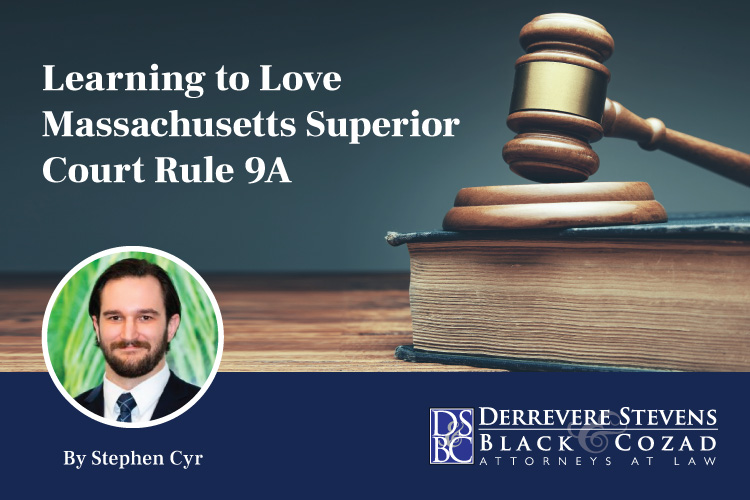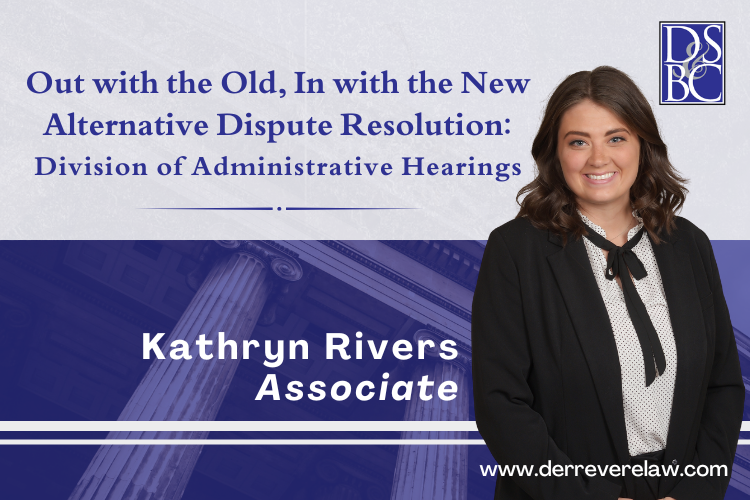Learning to Love Massachusetts Superior Court Rule 9A

Most Massachusetts attorneys have likely heard other attorneys, or have themselves bemoaned one of many Massachusetts-specific rules or requirements that tend to frustrate practicing attorneys: the need for blue ink signatures; the need for original summonses to file with the court; or the dreaded 9C conference—the list goes on.
However, few rules are as frustrating to many as Superior Court Rule 9A. While I have admittedly had my duels with the somewhat onerous requirements of this rule, over time my once sworn enemy has become my dear friend.
The predictability and routine nature of Superior Court Rule 9A can be a boon to any attorney so long as they break down the rule and make it a mechanical process that everyone can follow. In the next few steps, I am going to walk through the basic requirements for the rule and outline a few additional helpful tips. This is ONLY applicable in Superior Court so don’t go filing 9A Packages in district court or risk the ire of district court attorneys, clerks, and judges alike.
A few caveats before I begin: (1) do yourself a favor and download the PDF if you have not reviewed the rule before, it is far easier to read…at least for me; (2) this is not an exhaustive breakdown of Superior Court Rule 9A…this is an eight (8) page rule, review it, double-check it, triple-check it, until you are comfortable with its ins and outs; (3) I am not going to outline the requirements under 9A for dispositive motions or Summary Judgment Motions—be sure to review those specific requirements…there are a number of them… I may cover these in a separate post; and (4) make sure you check the rules often—Rule 9A is one of the more frequently updated rules, do not get your motion rejected because you failed to comply with a new requirement or update.
- Step 1: Determine if you need to talk to opposing counsel first
- Per the updated and fairly in-depth requirements under Superior Court Rule 9C, many motions filed in Superior Court now require attorneys to “confer” with opposing counsel in advance to filing a Motion. Be sure to review Superior Court Rule 9C closely. If all else fails, it is never a bad idea to talk to opposing counsel. If you do confer, draft a 9C Certificate and include it with your 9A Package…it never hurts. Also, you can confer after you have drafted the Motion/Memorandum discussed in Step 2.
- Step 2: Draft your Motion AND Memorandum!
- Yes, that is right, you need both. Per Superior Court Rule 9A(1) you need both a Motion and then a separate Memorandum of Law stating the reasons why said Motion should be granted. I know what everyone will say, “but I have filed a Motion without a Memorandum and it was granted.” And you are not wrong, but what works and what are best practices will always be two different animals. As they say, “thems the rules.” My personal recommendation, if you must file a Motion without a Memorandum—make sure it is either unopposed or a joint motion.
- Step 3: Serve your Motion, Memorandum, and Certificate of Service
- When you send your Motion and Memorandum to opposing counsel, be sure to include a Certificate of Service—you will need this later for the 9A Package. Per 9A(b)(1)(iii), Electronic Service, which is my preferred method, is permitted. Make sure to include in said Certificates of Service “served via email” so that scanned signatures can be accepted by the Court.
- Step 4: Waiting Game (give it 13 days)
- For typical Motions (i.e. NOT discovery or dispositive motions) you have ten (10) days after serving the motion/memo to withdraw or file the same, but an additional three (3) business days is permitted for service of the Opposition. This portion is somewhat convoluted and confusing. Simplified, just wait thirteen (13) days for opposing counsel to serve you with their opposition and you should not have any issues.
- Step 5: 9A Package (two potential options)
- Option 1 (No Opposition): If opposing counsel doesn’t serve you with an opposition within thirteen (13) days, you can now get your 9A package ready for filing. You will need to include the following in the 9A package (1) Motion; (2) Memorandum; (3) Original Certificate of Service—from Step 3; (4) Notice of Filing; (5) Affidavit of Compliance with 9A; (6) NEW Certificate of Service which serves Opposing Counsel with your Notice of Filing and Affidavit of Compliance with 9A. Send it to the Clerk and wait for the court to grant the same…unless you failed to follow the rule!
- Option 2 (Opposition – “to reply, or not reply”): So you got an opposition. You can either choose to draft a reply or get your 9A package ready. Per the rule, a Reply should only address NEWLY raised issues in the Opposition. Do not be that attorney that always files a Reply, though it is a crime we have all been guilty of. If new issues are raised, then draft one, otherwise get that 9A Package ready! In this instance your 9A Package will include the following: (1) Motion; (2) Memorandum; (3) Original Certificate of Service—from Step 3; (4) Opposition; (5) Notice of Filing; (6) Affidavit of Compliance with 9A; and (7) NEW Certificate of Service which serves Opposing Counsel with your Notice of Filing and Affidavit of Compliance with 9A.
- Step 6: Additional Helpful Tips
- Always, always, always, send the 9A Package with a letter that outlines in order the documents included therein. This will make the job of the clerks easier, and anything you can do to make their lives easier will come back tenfold.
- IF, you are filing/serving hard copies, i.e. not exchanging the Motion documents electronically, and the documents are physically signed with a pen. Make sure to sign them in blue ink and retain the originals. Serve opposing counsel with copies of everything. This is needed so you can then file the originals with the court in your 9A package.
- If you are served with a Motion and opposing counsel fails to comply with 9A, do not expect that to kill their motion. Prepare as if the court will hear arguments, and get your opposition into the court. I have seen so many cases get muddied because someone failed to comply with 9A, the court didn’t notice, the court granted the motion and here you are trying to wind the clock back.
- Finally, if you have a good grasp of Rule 9A, be sure to educate others, paralegals, new associates, legal secretaries, etc. This can be helpful to both make your life easier when it comes to serving and filing motions, and a good way to familiarize yourself further with the rules.
Well, there you have it. In my effort to break down the rule, I wrote another 1,000+ words about it. C’est la vie. Take your time. Check the rules. Have some fun, and at the end of the day, I am sure 9A will grow on you…like some strange legal fungus.




